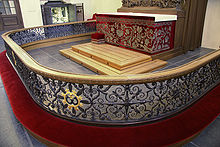Communion bench

A communion bench is a bench in front of the sanctuary on which the believers kneel to receive communion . Communion benches are mainly found in Catholic churches. In Scandinavia and southern Schleswig they are also part of the fixed church inventory in many Lutheran churches. Regionally, the communion rail, which also functions as a is choir screen can have, because of their design grain grid called.
history
Historically, communion pews are one of the numerous forms of boundary that has separated the area of the altar and the clergy from the area of the people in churches from the earliest times . In ancient times, stone choir screens were the rule. From this the iconostasis developed in the east and the rood screen in the west .
When it became common to kneel when receiving the Eucharist , the form of the communion bench emerged, which in the Baroque period was mostly made of marble or wood. Parts of the choir screens were usually designed as doors that could be opened so that access from the altar remained possible. A free space had to remain behind the communion bench up to the lowest altar step so that the priest could walk along the communion bench from one of the kneeling believers to the next. When using the communion bench, a cloth was covered over it, which could be attached to buttons on the back with loops. This communion bench or "food towel" originally served to catch any fallen particles of the host , later it was intended to support the idea of the communion bench as the Lord's table. It was mostly made of linen and could have lace trim or an embroidered border.
After the liturgical reform of the Second Vatican Council , communion in hand , which was usually received standing, became common in many places . As a result, many communion pews lost their function and were removed or moved to other places in the church because space was needed for the newly introduced popular altar . Sometimes parts of the communion pews were also used to make these new altars.
The then Pope Benedict XVI. Since the Feast of Corpus Christi 2008 only donates communion on the mouth , which should be received while kneeling. His example also revitalized the communion pews.
literature
- Adolf Adam and Rupert Berger , Pastoral-liturgisches Handlexikon , Freiburg 1980, pp. 19-20.
Individual evidence
- ^ Robert B. Witte: The Catholic House of God, Mainz 1939, pp. 97, 222.
- ↑ Joseph Braun : The Liturgical Paraments in the present and past. A manual of paramentics. 2nd, improved edition. Herder, Freiburg (Breisgau) 1924 (Reprographischer Reprint. Verlag Nova und Vetera, Bonn 2005, ISBN 3-936741-07-7 ), p. 232 f.
- ^ Office for the Liturgical Celebrations of the Pope, Studies of the Consultors: Communion received on the tongue and while kneeling
